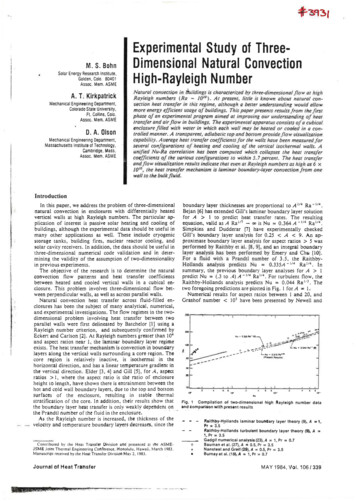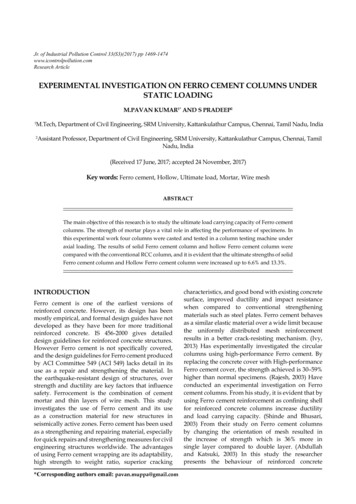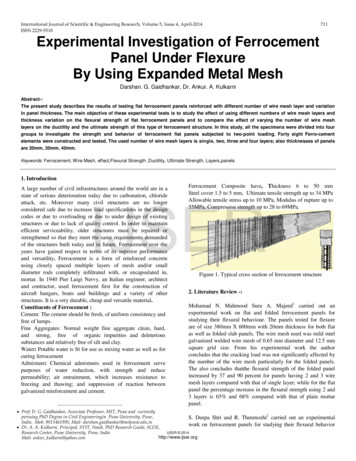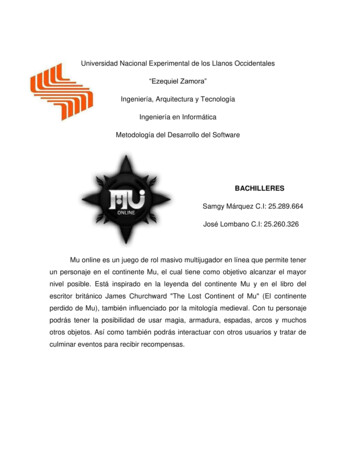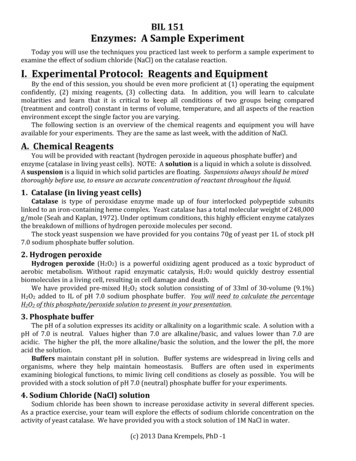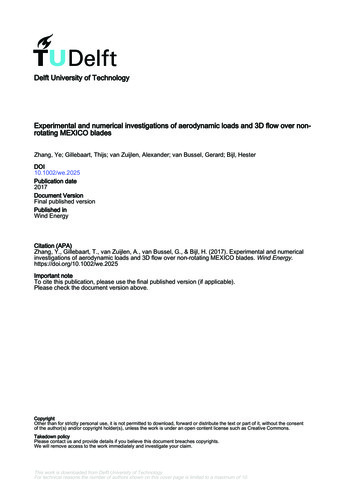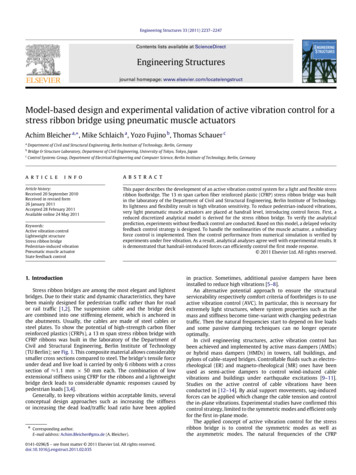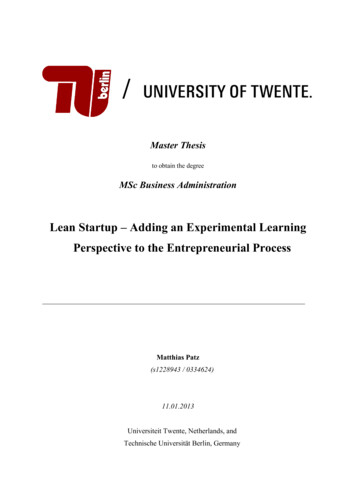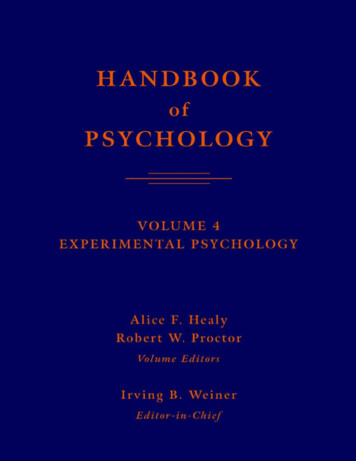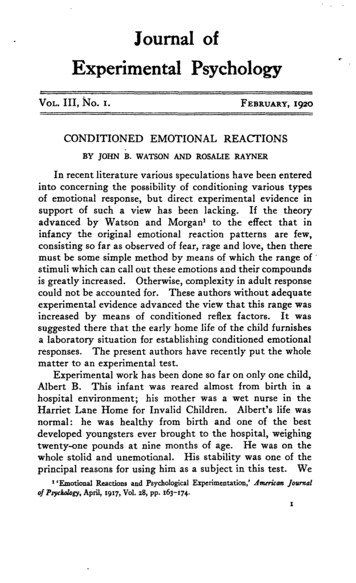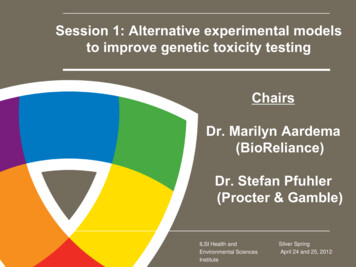
Transcription
Session 1: Alternative experimental modelsto improve genetic toxicity testingChairsDr. Marilyn Aardema(BioReliance)Dr. Stefan Pfuhler(Procter & Gamble)ILSI Health andEnvironmental SciencesInstituteSilver SpringApril 24 and 25, 2012
Agenda Introduction – Dr. Marilyn Aardema (BioReliance, USA) Overview of the use of 3-dimensional tissue constructs forgenotoxicity testing– Dr. Stefan Pfuhler (Procter & Gamble, USA) Development of in vitro toxicity testing using hepatocytesdifferentiated from human stem cells– Dr. Seiichi Ishida (NIHS, Japan) Humanized models in toxicology and their applications to hazardcharacterization and risk assessment– Dr. Darrell Boverhof (Dow Chemical, USA) Session 1 Discussion—SWOT analysesILSI Health andEnvironmental SciencesInstitute2
Rationale for the Topics in Session 1 New technologies are available/being developed Need to consider how to apply these in the field of genetic toxicology What is needed to foster their use globally What can ILSI-HESI do to facilitate use? One major focus is on more biologically relevanthuman-based models Stem cells 3D Humanized animal modelsCellsTissuesILSI Health andEnvironmental SciencesInstituteAnimal Models
Tool orassaySWOT analysis: Name of the assayStrengths- What advantages over other technologiesdoes the assay you will describe offer?- The assay you will describe beingused in laboratories other than yours/ thetechnology available to other potentiallyinterested investigators?-Large data base (specify classes ofcompounds)?- OthersOpportunities- How do you envision this method be used inregulatory research scenarios?- At what stage of hazard/risk assessment?- Collaborative effort needed/recommended?- What questions does data from this assayanswer about the qualitative or quantitativehazard (genotoxic risk?) for the individualcompound being tested?-OthersILSI Health andEnvironmental SciencesInstituteWeaknesses- The assay you will describe not beingused in laboratories other than yours/ thetechnology not available to other potentiallyinterested investigators?-Limited data base (specify classes ofcompounds)?- OthersThreats- What barriers do you see to wider acceptanceof this method?- Does patent protection limit other’s access tothe technology?- Others
Strengths- What advantages over other technologiesdoes the assay you describe offer?- How widely is the assay used?- How large is the data base (specify classes ofcompounds)ILSI Health andEnvironmental SciencesInstitute
Weaknesses-What is missing from the assay/approach?ILSI Health andEnvironmental SciencesInstitute
Opportunities- How do you envision this method being usedin regulatory research scenarios?- Hazard assessment?- Rish assessment?- Is a collaborative effortneeded/recommended to gain wider use?- What questions does data from this assayanswer about the qualitative or quantitativehazard (genotoxic risk?) for the individualcompound being tested?ILSI Health andEnvironmental SciencesInstitute
Threats- What barriers do you see to wider acceptanceof this method?- Does patent protection limit other’s access tothe technology?- OthersILSI Health andEnvironmental SciencesInstitute
What can ILSI-HESI Do? Hold more meetings/workshops IVGT could interface with Risk21 Should we evaluate same compounds tobridge in vitro and in vivo using these assays Should ILSI make recommendations onwhether a technology can replace previousassays Cell bank – include cells to be used fordeveloping modelsILSI Health andEnvironmental SciencesInstitute
Discussion Physiological anchoring– Key to interpreting in vitro assays – are assay conditions reflective of invivo physiological parameters (also prolif., metabolic parameters);need to understand relevance What is the endgame – are we better off than previously What question or we trying to answer? (e.g., are we predictingcancer, understanding animal/human differences) What are gaps in current way of doing RA? For RA – only use guideline studies– Test battery locks us in– Single battery does not answer all questions – need to understandquestions – test battery is nice way to start when you don’t knowanything about the compound– After doing test battery – move on to other studies to betterunderstand compoundILSI Health andEnvironmental SciencesInstitute
Tool orassaySWOT analysis: 3D tissue constructsStrengths- More closer to ‘in vivo’ conditions-Closer to in vivo means prolif. – more difficult for genetox(trading off false positives for false negatives) – could be anopportunity to develop better models-Model-specific approach; tissue should prolif. as normal aspossible – but respond appropriately to toxic insult- Cells are of human origin and function more organ-like in termsof cell viability, proliferation, differentiation, morphology, geneand protein expression- Large interest in assay, used by increasing no. of laboratories invarious geographies- (Pre) Validation exercise ongoing for 3D skin-3D skin / liver – testing for known genetox endpoints – surrogatemodel ILSI Health andEnvironmental SciencesInstitute
Tool orassaySWOT analysis: 3D tissue constructsWeaknesses- More difficult to handle and more expensive- High throughput possible only for low-complexity models- Various levels of supporting data available - minimal to moderate- Used in limited no of labs- Assays at stage of early development for some modelsILSI Health andEnvironmental SciencesInstitute
Tool orassaySWOT analysis: 3D tissue constructsOpportunities- 3D constructs have the potential to serve as 2nd tear assays tofollow up on positives from 1st tier- Collaborative efforts recommended for relevant tissues for whichno such efforts are currently ongoing (liver, lung)- May be useful also to help bridge gap between in vitro and in vivoin terms of quantitative risk assessment-Don’t generally do quant RA on in vitro tests-Could define internal dose – but need to normalize data- tools to dive in deeper – (not replacement assays)-Or use for specific chem class where we know that existingassays don’t work well-We don’t need these for screening but for filling gaps-Need to know what we are trying to modelILSI Health andEnvironmental SciencesInstitute
Tool orassaySWOT analysis: 3D tissue constructsThreats- Validation of methods is very source intense- Limited availability of tissue constructs, price, potentialissues with patents (?)- Variability of human tissuesILSI Health andEnvironmental SciencesInstitute
Seiichi Ishida NIHS, JapanTool orassaySWOT analysis: Hepatotoxicity TEST by stem cell derivedhepatocyteStrengths-Theoretically unlimited supply of human hepatocytes-Supply of hepatocytes with different genetic background-Supply of hepatocytes from patients suffering specific diseases-Simultaneous analysis of multiple drug metabolism cascade inone cell-Model human metabolism including polymorphisms (differencesin susceptibilities)-Surrogate for replacement, model human,-Need to understand assay limitations-Need clarification on hazard ID (genetox, carcinogenesis)-Need to understand gene expression during differentiation-Sequence stem cell genome (cell banks can do this) – need tocharacterize epigenome as wellILSI Health andEnvironmental SciencesInstitute
Seiichi Ishida NIHS, JapanTool orassaySWOT analysis: Hepatotoxicity TEST by stem cell derivedhepatocyteWeaknesses-Complexity of differentiation process of stem cells intohepatocytes-Low reproducibility of differentiation process-Expensive costILSI Health andEnvironmental SciencesInstitute
Seiichi Ishida NIHS, JapanTool orassaySWOT analysis: Hepatotoxicity TEST by stem cell derivedhepatocyteOpportunities-Replacement of human primary hepatocyte-Replacement of animal toxicity testing-Improvement of heptatotoxicity prediction-Evaluation of hepatotoxicity, prediction of metabolites, predictionof induction of drug metabolism-relating enzymes, and prediction ofdrug-drug interaction-Supply of metabolites to other testing, i.e. gentoxicity testing-At early stage of drug developmentILSI Health andEnvironmental SciencesInstitute
Seiichi Ishida NIHS, JapanTool orassaySWOT analysis: Hepatotoxicity TEST by stem cell derivedhepatocyteThreats-Complexity of differentiation process-Requirements of higher hepatocyte activities-Establishment of standards for hepatocyte qualification-Hepatocyte progenitor cell line: HepaRGILSI Health andEnvironmental SciencesInstitute
Tool orassaySWOT analysis: Humanized Animal ModelsStrengths-Allows for better characterization of human hazard and risk potential- Humanrelevant-Provides additional data on mode/mechanism of action-Different knockout models (p53) – also crossed with lacZ animals; RIVM also has DNArepair-deficient models;ILSI Health andEnvironmental SciencesInstitute
Tool orassaySWOT analysis: Humanized Animal ModelsWeaknesses-Involves animal use-Expensive (creation and maintenance)-Low-throughput-Transgenic models- human gene product in mouse environmentILSI Health andEnvironmental SciencesInstitute
Tool orassaySWOT analysis: Humanized Animal ModelsOpportunities-Allow for refinement in hazard and risk assessments-decreased uncertainty-increased human relevance-New technologies are decreasing the cost and expanding the model species-Can be used to further define “toxicity pathways” thereby facilitating development ofin vitro assays based on MoA-Can be used to validate in vitro hypothesesILSI Health andEnvironmental SciencesInstitute
Tool orassaySWOT analysis: Humanized Animal ModelsThreats-Models not widely availableModels using different technologies may generate different results- may delayprogressLack of acceptance of this technology for advancing human health riskassessmentsILSI Health andEnvironmental SciencesInstitute
In vitro toxicity testing using hepatocytesStrengths- Theoretically unlimited supply of humanhepatocytes- Supply of hepatocytes with different geneticbackground- Supply of hepatocytes from patients sufferingspecific diseases- Simultaneous analysis of multiple drugmetabolism cascade in one cellILSI Health andEnvironmental SciencesInstitute
In vitro toxicity testing using hepatocytesWeaknesses- Complexity of differentiation process of stemcells into hepatocytes- Low reproducibility of differentiation process- Expensive costILSI Health andEnvironmental SciencesInstitute
In vitro toxicity testing using hepatocytesOpportunities-Replacement of human primary hepatocyteReplacement of animal toxicity testingImprovement of heptatotoxicity predictionEvaluation of hepatotoxicity, prediction ofmetabolites, prediction of induction of drugmetabolism-relating enzymes, and prediction ofdrug-drug interaction- Supply of metabolites to other testing, i.e. gentoxicitytesting- At early stage of drug developmentILSI Health andEnvironmental SciencesInstitute
In vitro toxicity testing using hepatocytesThreats- Complexity of differentiation process- Requirements of higher hepatocyte activities- Establishment of standards for hepatocytequalification- Hepatocyte progenitor cell line: HepaRGILSI Health andEnvironmental SciencesInstitute
03.06.2016 · –Dr. Stefan Pfuhler (Procter & Gamble, USA) Development of in vitro toxicity testing using hepatocytes differentiated from human stem cells –Dr. Seiichi Ishida (NIHS, Japan) Humanized models in toxicology and their applications to hazard characterization and risk assessment –Dr. Darrell Boverhof (Dow Chemical, USA) Session 1 Discussion—SWOT analyses 2 Agenda . ILSI Health .

